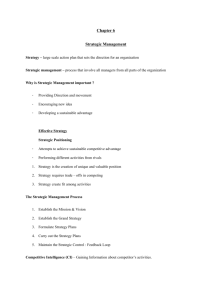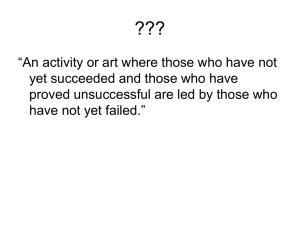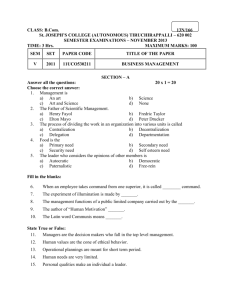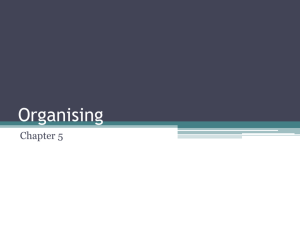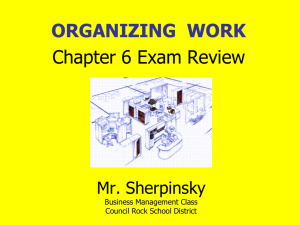Management Process Exam: Organizing, Delegation, Staffing
advertisement
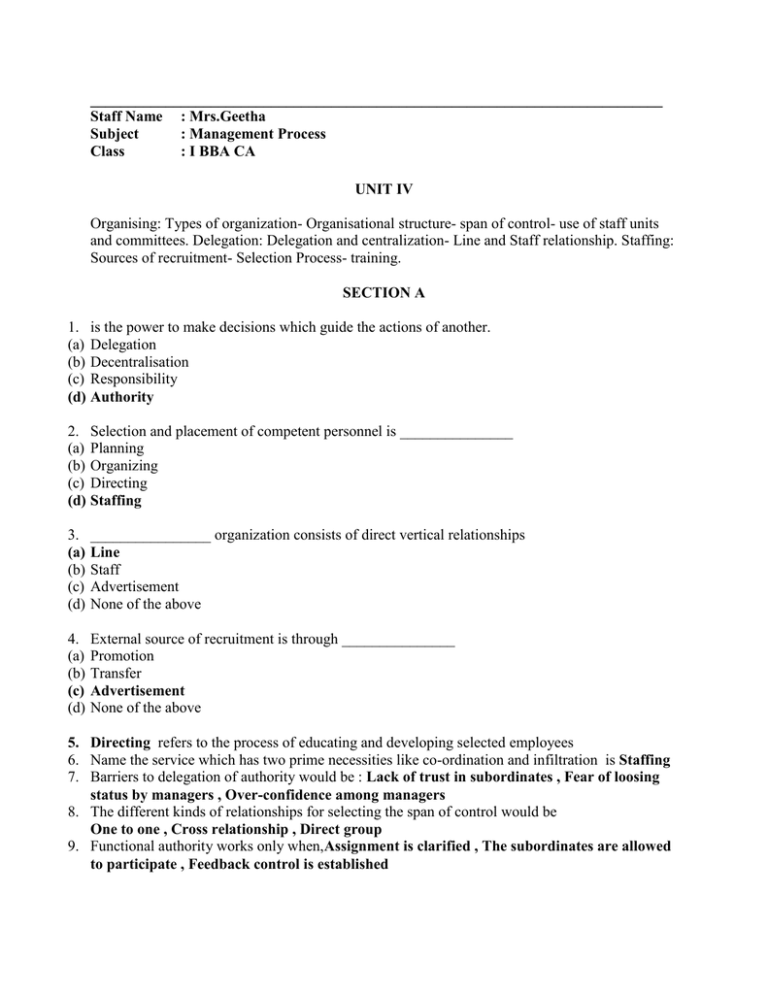
____________________________________________________________________________ Staff Name : Mrs.Geetha Subject : Management Process Class : I BBA CA UNIT IV Organising: Types of organization- Organisational structure- span of control- use of staff units and committees. Delegation: Delegation and centralization- Line and Staff relationship. Staffing: Sources of recruitment- Selection Process- training. SECTION A 1. is the power to make decisions which guide the actions of another. (a) Delegation (b) Decentralisation (c) Responsibility (d) Authority 2. Selection and placement of competent personnel is _______________ (a) Planning (b) Organizing (c) Directing (d) Staffing 3. (a) (b) (c) (d) ________________ organization consists of direct vertical relationships Line Staff Advertisement None of the above 4. (a) (b) (c) (d) External source of recruitment is through _______________ Promotion Transfer Advertisement None of the above 5. Directing refers to the process of educating and developing selected employees 6. Name the service which has two prime necessities like co-ordination and infiltration is Staffing 7. Barriers to delegation of authority would be : Lack of trust in subordinates , Fear of loosing status by managers , Over-confidence among managers 8. The different kinds of relationships for selecting the span of control would be One to one , Cross relationship , Direct group 9. Functional authority works only when,Assignment is clarified , The subordinates are allowed to participate , Feedback control is established 10. What is essential for the management to get things done in the organization? Delegation SECTION B 1. What is the Meaning of Organising? Organizing (also spelled organising) is the act of rearranging elements following one or more rules. Anything is commonly considered organized when it looks like everything has a correct order or placement. But it's only ultimately organized if any element has no difference on time taken to find it. In that sense, organizing can also be defined as to place different objects in logical arrangement for better searching. Organizations are groups of people frequently trying to organize some specific subject, such as political issues. So, even while organizing can be viewed as a simple definition, it can get as complex as organizing the world's information. 2. Explain the Span of Control Span of control is a term originating in military organization theory, but now used more commonly in business management, particularly human resource management. Span of control refers to the number of subordinates a supervisor has. In the hierarchical business organization of the past it was not uncommon to see average spans of 1 to 4 or even less. That is, one manager supervised four employees on average. In the 1980s corporate leaders flattened many organizational structures causing average spans to move closer to 1 to 10. That was made possible primarily by the development of inexpensive information technology. As information technogy was developed capable of easing many middle manager tasks – tasks like collecting, manipulating and presenting operational information – upper managers found they could hire fewer middle managers to do more work managing more subordinates for less money. The current shift to self-directed cross-functional teams and other forms of non-hierarchical structures, have made the concept of span of control less salient. Factors affecting span of control These are the factors affecting span of control: Geographical Location, if the branches of a business are widely dispersed, then the manager will find it difficult to supervise each of them, as such the span on control will be smaller. Capability of workers, if workers are highly capable, and do not require much supervision and can be left on their own, eg: Theory Y type of people, need not be supervised much as they are motivated and take initiative to work,as such the span of control will be smaller. Similarity of task, if the task that the subordinates are performing are similar, then the span of control can be wider, as the manager can supervise them all at the same time. However, of course the capability of the supervisor has to also be taken into consideration 3. Delegation Meaning and Definition and its types A kind of novation by which a debtor, to be liberated from his creditor, gives him a third person, who becomes obliged in his stead to the creditor, or to the person appointed by him. The act of delegating, or investing with authority to act for another; the appointment of a delegate or delegates. One or more persons appointed or chosen, and commissioned to represent others, as in a convention, in Congress, etc.; the collective body of delegates; as, the delegation from Massachusetts; a deputation Centralization Centralization is said to be a process where the concentration of decision making is in a few hands. All the important decision and actions at the lower level, all subjects and actions at the lower level are subject to the approval of top management. According to Allen, “Centralization” is the systematic and consistent reservation of authority at central points in the organization. The implication of centralization can be : Reservation of decision making power at top level. Reservation of operating authority with the middle level managers. Reservation of operation at lower level at the directions of the top level. Under centralization, the important and key decisions are taken by the top management and the other levels are into implementations as per the directions of top level. For example, in a business concern, the father & son being the owners decide about the important matters and all the rest of functions like product, finance, marketing, personnel, are carried out by the department heads and they have to act as per instruction and orders of the two people. Therefore in this case, decision making power remain in the hands of father & son. Decentralization On the other hand, Decentralization is a systematic delegation of authority at all levels of management and in all of the organization. In a decentralization concern, authority in retained by the top management for taking major decisions and framing policies concerning the whole concern. Rest of the authority may be delegated to the middle level and lower level of management. The degree of centralization and decentralization will depend upon the amount of authority delegated to the lowest level. According to Allen, “Decentralization refers to the systematic effort to delegate to the lowest level of authority except that which can be controlled and exercised at central points. Decentralization is not the same as delegation. In fact, decentralization is all extension of delegation. Decentralization pattern is wider is scope and the authorities are diffused to the lowest most level of management. Delegation of authority is a complete process and takes place from one person to another. While decentralization is complete only when fullest possible delegation has taken place. For example, the general manager of a company is responsible for receiving the leave application for the whole of the concern. The general manager delegates this work to the personnel manager who is now responsible for receiving the leave applicants. In this situation delegation of authority has taken place. On the other hand, on the request of the personnel manager ,if the general manager delegates this power to all the departmental heads at all level, in this situation decentralization has taken place. There is a saying that “Everything that increasing the role of subordinates is decentralization and that decreases the role is centralization”. Decentralization is wider in scope and the subordinate’s responsibility increase in this case. On the other hand, in delegation the managers remain answerable even for the acts of subordinates to their superiors. Implications of Decentralization There is less burden on the Chief Executive as in the case of centralization. 1. In decentralization, the subordinates get a chance to decide and act independently which develops skills and capabilities. This way the organization is able to process reserve of talents in it. 2. In decentralization, diversification and horizontal can be easily implanted. 3. In decentralization, concern diversification of activities can place effectively since there is more scope for creating new departments. Therefore, diversification growth is of a degree. 4. In decentralization structure, operations can be coordinated at divisional level which is not possible in the centralization set up. 5. In the case of decentralization structure, there is greater motivation and morale of the employees since they get more independence to act and decide. 6. In a decentralization structure, co-ordination to some extent is difficult to maintain as there are lot many department divisions and authority is delegated to maximum possible extent ,i.e., to the bottom most level delegation reaches. Centralization and decentralization are the categories by which the pattern of authority relationships became clear. The degree of centralization and de-centralization can be affected by many factors like nature of operation, volume of profits, number of departments, size of a concern, etc. The larger the size of a concern, a decentralization set up is suitable in it. SECTION C 1. Enumerate the Organisation structure and Types Organisation types One of the most challenging tasks of a business may be organizing the people who perform its work. A business may begin with one person doing all the necessary tasks. As the business becomes successful and grows, however, there is generally more work, and more people are needed to perform various tasks. Through this division of work, individuals can become specialists at a specific job. Because there are several people—often in different locations— working toward a common objective, "there must be a plan showing how the work will be organized. The plan for the systematic arrangement of work is the organization structure. Organization structure is comprised of functions, relationships, responsibilities, authorities, and communications of individuals within each department" (Sexton, 1970, p. 23). The typical depiction of structure is the organizational chart. The formalized organizational chart has been around since 1854, when Daniel McCallum became general superintendent of the New York and Erie Railroad—one of the world's longest railroads. According to McCallum, since the railroad was one of the longest, the operating costs per mile should be less than those of shorter railroad lines. However, this was not the case. To remedy management inefficiencies, McCallum designed the first organizational chart in order to create a sense of structure. The organizational chart has been described as looking like a tree, with the roots representing the president and the board of directors, while the branches symbolize the various departments and the leaves depict the staff workers. The result of the organizational chart was a clear line of authority showing where subordinates were accountable to their immediate supervisors (Chandler, 1988, p. 156). Traditional Structures: Traditional organizational structures focus on the functions, or departments, within an organization, closely following the organization's customs and bureaucratic procedures. These structures have clearly defined lines of authority for all levels of management. Two traditional structures are line and line-and-staff. Line Structure: The line structure is defined by its clear chain of command, with final approval on decisions affecting the operations of the company still coming from the top down (Figure 1). Because the line structure is most often used in small organizations—such as small accounting offices and law firms, hair salons, and "mom-and-pop" stores—the president or CEO can easily provide information and direction to subordinates, thus allowing decisions to be made quickly. Line structures by nature are fairly informal and involve few departments, making the organizations highly decentralized. Employees are generally on a first-name basis with the president, who is often available throughout the day to answer questions and/or to respond to situations as they arise. It is common to see the president or CEO working alongside the subordinates. Because the president is often responsible for wearing many "hats" and being responsible for many activities, she or he cannot be an expert in all areas. Line-And-Staff Structure: While the line structure would not be appropriate for larger companies, the line-and-staff structure is applicable because it helps to identify a set of guidelines for the people directly involved in completing the organization's work. This type of structure combines the flow of information from the line structure with the staff departments that service, advise, and support them (Boone and Kurtz, 1993, p. 259). Line departments are involved in making decisions regarding the operation of the organization, while staff areas provide specialized support. The line-and-staff organizational structure "is necessary to provide specialized, functional assistance to all managers, to ensure adequate checks and balances, and to maintain accountability for end results" (Allen, 1970, p. 63). An example of a line department might be the production department because it is directly responsible for producing the product. A staff department, on the other hand, has employees who advise and assist—making sure the product gets advertised or that the customer service representative's computer is working (Boone and Kurtz, 1993, p. 259). Based on the company's general organization, line-and-staff structures generally have a centralized chain of command. The line-and-staff managers have direct authority over their subordinates, but staff managers have no authority over line managers and their subordinates. Because there are more layers and presumably more guidelines to follow in this type of organization, the decision-making process is slower than in a line organization. The line-and-staff organizational structure is generally more formal in nature and has many departments. 2. Define Staffing and recruitment and explain the sources of recruitment Note that the word "hiring" is sometimes used interchangeably with "staffing", which does an injustice to the broad scope of activities involved in staffing. Hiring might be thought more specifically as the selection phase of the overall process of staffing. Also note that the word "Recruitment" is sometimes used interchangeably with "staffing", although many see "recruiting" as referring more specifically to the sourcing and advertising phases of the overall process of staffing. Meaning of Recruitment Recruitment refers to the process of attracting, screening, and selecting qualified people for a job at an organization or firm. For some components of the recruitment process, mid- and largesize organizations often retain professional recruiters or outsource some of the process to recruitment agencies. The recruitment industry has five main types of agencies: employment agencies, recruitment websites and job search engines, "headhunters" for executive and professional recruitment, niche agencies which specialize in a particular area of staffing and in-house recruitment. The stages in recruitment include sourcing candidates by advertising or other methods, and screening and selecting potential candidates using tests or interviews. Sources of Recuirtment Every organisation has the option of choosing the candidates for its recruitment processes from two kinds of sources: internal and external sources. The sources within the organisation itself (like transfer of employees from one department to other, promotions) to fill a position are known as the internal sources of recruitment. Recruitment candidates from all the other sources (like outsourcing agencies etc.) are known as the external sources of The recruitment SOURCES OF RECRUITMENT Internal Sources Some Internal Sources Of Recruitments are given below: Transfers The employees are transferred from one department to another according to their efficiency and experience. Promotions The employees are promoted from one department to another with more benefits and greater responsibility based on efficiency and experience. Others are Upgrading and Demotion of present employees according to their performance. Retired and Retrenched employees may also be recruited once again in case of shortage of qualified personnel or increase in load of work. Recruitment such people save time and costs of the organisations as the people are already aware of the organisational culture and the policies and procedures. The dependents and relatives of Deceased employees and Disabled employees are also done by many companies so that the members of the family do not become dependent on the mercy of others. External sources Press advertisements Advertisements of the vacancy in newspapers and journals are a widely used source of recruitment. The main advantage of this method is that it has a wide reach. Educational institutes Various management institutes, engineering colleges, medical Colleges etc. Are a good source of recruiting well qualified executives, engineers, medical staff etc. They provide facilities for campus interviews and placements. This source is known as Campus Recruitment. Placement agencies Several private consultancy firms perform recruitment functions on behalf of client companies by charging a fee. These Agencies are particularly suitable for recruitment of executives and specialists. It is also known as RPO (Recruitment Process Outsourcing) Employment exchanges Government establishes public employment exchanges throughout the country. These exchanges provide job information to job seekers and help employers in identifying suitable candidates. Labour contractors Manual workers can be recruited through contractors who maintain close contacts with the sources of such workers. This source is used to recruit labour for construction jobs. Unsolicited applicants Many job seekers visit the office of well-known companies on their own. Such callers are considered nuisance to the daily work routine of the enterprise. But can help in creating the talent pool or the database of the probable candidates for the organisation. Employee referrals / recommendations Many organisations have structured system where the current employees of the organisation can refer their friends and relatives for some position in their organisation. Also, the office bearers of trade unions are often aware of the suitability of candidates. Recruitment Management can inquire these leaders for suitable jobs. In some organizations these are formal agreements to give priority in recruitment to the candidates recommended by the trade union. Recruitment at factory gate Unskilled workers may be recruited at the factory gate these may be employed whenever a permanent worker is absent. More efficient among these may be recruited to fill permanent vacancies. 3. Explain The Selection Process and training process The rules governing selection require that all employees be selected and promoted through a competitive examination of merit and fitness. That being said, the end result of the selection process is to arrive at a top group of three (3) applicants from the applicant pool for the appointing authority (supervisor who is hiring for this position) to select from. The top group of three (3) applicants are derived from testing and/or other assessments of their knowledge, skills, abilities and other characteristics needed to successfully perform the job. Typically, the process of arriving at a top group of three (3) individuals follows the following architecture: Position announcement All open-competitive career opportunities at CDPHE are announced on the Colorado State Government Job Announcement website. Please see Current Job Opportunities Accepting applications CDPHE is an Equal Opportunity Employer (see Diversity Policy) The CDPHE Human Resources Office only accepts applications for announced positions. Applications for announced positions will be accepted until the closing date advertised on the job announcement. You must be a resident of Colorado to apply. Application screening Submitted applications are reviewed to identify applicants meeting the minimum requirements listed in the job announcement. All applicants who meet the minimum qualifications for a posted position are invited to participate in a fair and open competitive examination of job-relevant competencies. Applicants who do not meet the minimum requirements are notified by electronic mail of their status. Examination process When filling a vacant position, the State of Colorado requires the use of an examination process to identify the top three candidates. If three (3) or fewer candidates meet the minimum qualifications of the position vacancy, the minimum qualifications are the exam and all of the applicants are referred to the supervisor for interview. However, if more than three (3) applicants meet the minimum qualifications, an examination of job-related competencies must be used to determine the top three (3) candidates. The number and types of exams chosen for this process will depend on the job class of the position vacancy and the total number of qualified applicants competing for the position. Types of Tests Applicants will be notified of their status following test results. Generally applicants continuing in the process will not receive a notification with a score, but rather a notification regarding the next step in the exam process. Supervisor review & consideration The top three (3) candidates identified via the examination process will be referred to the supervisor of the position vacancy for interview The supervisor of the position vacancy will make the hiring decision. Typically, supervisors interview each of the candidates on their referral list. However, a supervisor is not required to interview each of the candidates before making a hiring decision. A review of each candidate’s resume and an interview with the candidate who is deemed the best fit for the position is sometimes sufficient to make a hiring decision. Job offer After careful consideration of each candidate, the supervisor makes the final decision.Depending on type of work performed in the position, a job offer may be contingent on the results of a drug test, physical examination and/or criminal background check. TRAINING AND TYPES The term training refers to the acquisition of knowledge, skills, and competencies as a result of the teaching of vocational or practical skills and knowledge that relate to specific useful competencies. It forms the core of apprenticeships and provides the backbone of content at institutes of technology (also known as technical colleges or polytechnics). In addition to the basic training required for a trade, occupation or profession, observers of the labor-market[who?] recognize today the need to continue training beyond initial qualifications: to maintain, upgrade and update skills throughout working life. People within many professions and occupations may refer to this sort of training as professional development. Some commentators use a similar term for workplace learning to improve performance: training and development. One can generally categorize such training as on-the-job or off-the-job: On-the-job training takes place in a normal working situation, using the actual tools, equipment, documents or materials that trainees will use when fully trained. On-the-job training has a general reputation as most effective for vocational work. Off-the-job training takes place away from normal work situations — implying that the employee does not count as a directly productive worker while such training takes place. Off-the-job training has the advantage that it allows people to get away from work and concentrate more thoroughly on the training itself. This type of training has proven more effective in inculcating concepts and ideas. Training differs from exercise in that people may dabble in exercise as an occasional activity for fun. Training has specific goals of improving one's capability, capacity, and performance.
